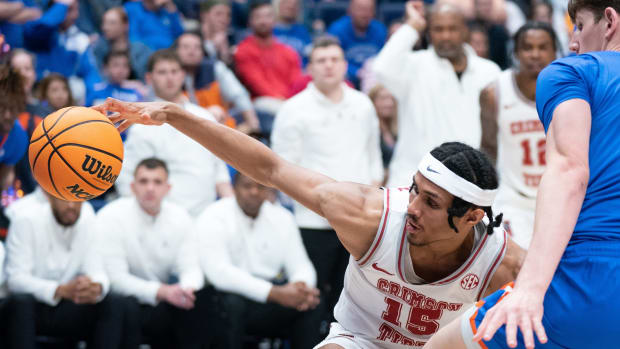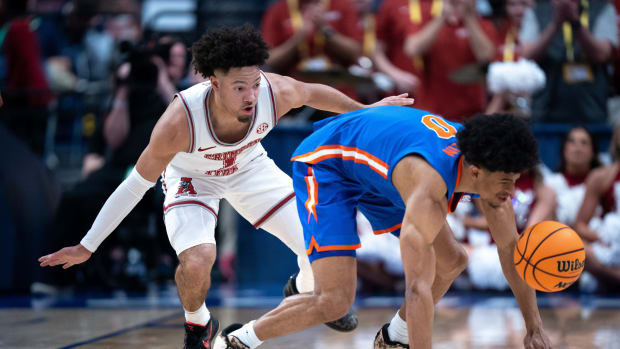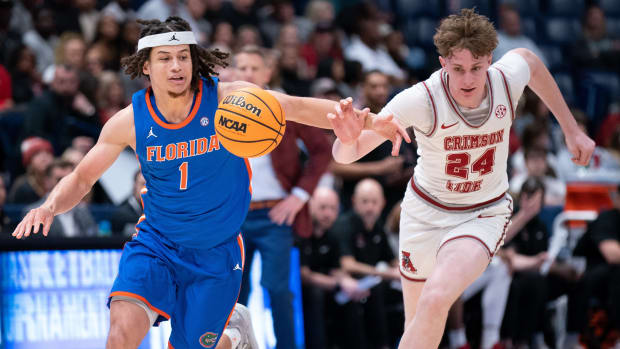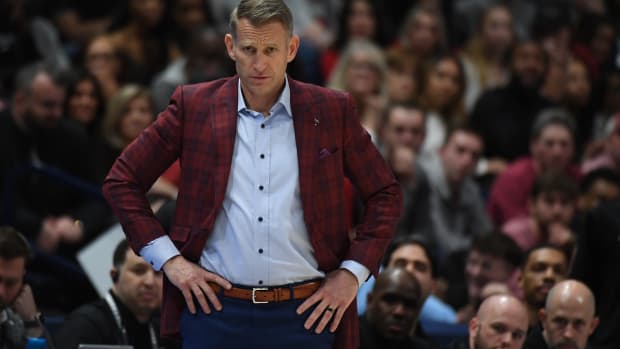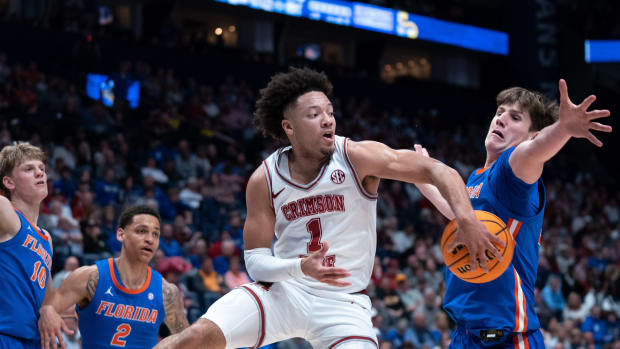Throwback Thursday: The Tuscaloosa Tornado
Something that a lot of University of Alabama fans may have forgotten over the years was that in the wake of the tornado that ripped through Tuscaloosa on April 27, 2011, the Crimson Tide football team would soon be dealing with another tragedy.
On May 11, Aaron Douglas, an incoming Alabama offensive lineman who previously spent two years at Tennessee, died in Jacksonville, Fla., due to an accidental drug overdose.
He was 21.
The day after Nick Saban and numerous players attended a memorial service for Doulas in Knoxville, Tenn., the coach was back in Tuscaloosa and attended a special radio broadcast called "Hey Coach … Helping Out,” to help raise money for UA’s Acts of Kindness Fund and other organizations involved in disaster relief.
“It’s just really sad,” said Saban, who wouldn't have been blamed for saying he couldn't make the show. But shirking responsibilities have never been the coach's thing.
In the three weeks since the disaster Saban had also been a spokesman during Crimson Caravan gatherings, participated in a fund-raising telethon, and set up a Nick’s Kids Foundation arm to help sponsor the rebuilding of a neighborhood.
That was on top of his wife Terry purchasing hundreds of $50 gift cards and handing them out so people could buy whatever they needed, visiting a shelter, and instructing his players to do whatever they could to help.
“Sometimes your presence means something and you just have to listen,” he said at the time. “We fed everyone and we gave away a thousand Alabama shirts, which everyone was really excited about. You would have thought we gave everyone an SUV they were so happy to have an Alabama shirt.
“You can watch all this on television and see the devastation, but until you meet the family that lost their home and all their belongings, things that were dear and personal to them, the guy who just lost his business, it was just blown away, but most importantly anyone who lost any loved ones. That’s the saddest thing.”
For Throwback Thursday this week, here are two excerpts, from Sports Illustrated and a book on Crimson Tide football about the tornado and its initial impact on Tuscaloosa.
Excerpt 1: Terror, Tragedy and Hope in Tuscaloosa
Sports Illustrated, May 23, 2011, by Lars Anderson
At 5:30 a.m. on April 27 in Tuscaloosa, Ala., in a four-bedroom, two-bathroom house at 611 25th Street, Carson Tinker was awakened by thunder. When he peered through his window that faced west, he saw flashes of lightning fracture the dark Southern sky. The bolts held his eyes.
That morning Tinker, 21, a junior and Alabama's starting long snapper, attended class and then picked up his girlfriend of 11 months, Ashley Harrison, a senior honors student. The two returned to Tinker's house for lunch, eating leftover ham-and-potato salad that Harrison had cooked for Easter three days earlier then settled into the living room couch to watch The NeverEnding Story. The movie soon bored Tinker, so he took his dog, Josie, a German shepherd mix, and Harrison's dog, B, a black Lab, to a large, grassy field across the street. Tinker hit golf balls; the dogs fetched. This field was one of Tinker's favorite places in Tuscaloosa. Framed by towering oaks, he felt at peace; aside from the occasional bark, the only sound was the wind strumming the leaves. He often called his time in the field with the dogs "one of the highlights of my day."
Tinker returned to the house an hour later. After showering he saw that Ashley and his two roommates—Alan Estis and Payton Holley—were riveted to the television. A weatherman declared in a raised voice that a tornado was tearing toward Tuscaloosa.
Tinker and Holley stepped onto their front porch, gazing upward, searching for a funnel cloud. All they saw was a dark spring sky. Tinker had planned to move to a neighbor's basement if a tornado was nearby, but he saw nothing. A few seconds later his cellphone bleated. It was his grandfather, Jim Cartledge, calling from Hoover, Ala. "Carson, you need to take cover now!"
"Yes, sir," Carson replied.
Tinker and Holley ran inside. What they couldn't see was that a few miles to the west of their house, the most powerful long-track tornado ever in Alabama, an EF-4 level twister with winds of 190 mph, was bearing down on them at 55 mph. Quickly the four students and the two dogs wedged themselves into a walk-in closet in Estis's bedroom. Tinker wrapped his 6'1", 220-pound frame around Harrison. "We're going to be O.K.," he said softly into her ear.
The tornado hit 611 25th Street with cruel directness. Cowering in the closet, crouched on the floor, Tinker held Harrison tight. As the winds roared—"It sounded like there was an F-18 in the front yard," Estis would later say—they could hear the walls creak. "I'm scared, Carson," Harrison said.
"It's going to be O.K.," Tinker shouted as the house began to disintegrate. "It's going to be O.K., Ashley."
Just then Tinker was sucked out of the closet, catapulted into the air like a rock by a giant slingshot and thrown 100 yards into the field he loved so much. He blacked out, concussed, and when he opened his eyes moments later he couldn't recognize anything. The oak trees had vanished; the house was a pile of rubble on the other side of the road. Ashley was gone.
In a suddenly perfect silence, Tinker wandered around the field. He had a broken right wrist, gashes in his head and a large cut on his right ankle. His body moved in slow motion, but with a sense of urgency. "Ashley, where are you?" he screamed. "Ashley!"
For at least 10 minutes, before his roommates, who were mostly unharmed, found him help, Tinker stumbled in circles, searching for the girl that he had been with almost every day for the past year. "Ashley," he screamed, "where are you?"
How do you tell the story of the deadliest tornado in the history of Alabama? As of Sunday, 41 were confirmed dead—including six students from the University of Alabama—and hundreds injured in Tuscaloosa and Tuscaloosa County alone. (A total of 238 people were killed by more than 60 tornadoes that ravaged the state on April 27.) But these raw numbers can't begin to account for the damage. Nearly every resident in the town of 90,000 has trouble sleeping, and when they do close their eyes and drift away, most are tormented by please-God-wake-me nightmares.
Lars Anderson is the author of the 2014 book: The Storm and the Tide: Tragedy, Hope and Triumph in Tuscaloosa
Except 2: The Tornado
By Christopher Walsh, 100 Things Crimson tide Fans Should Know & Do Before They Die
Everything changed on April 27, 2011.
It was an unusually warm day in Tuscaloosa, where most University of Alabama students were only dreading their upcoming finals and still basking from the unofficial offseason football holiday known as “A-Day.” Less than two weeks after the annual celebration surrounding the final scrimmage of spring practices, this one had been extra special because it had included Nick Saban having his statue unveiled in front of again-expanded Bryant-Denny Stadium, where the other coaches who have won national championships are permanently honored.
Intense warnings had been issued for that afternoon, but the sun had been out in between the passing storm clusters that have been known to frequent the South on a regular basis this time of the year. A particularly nasty one had come though in the early-morning hours, but still things went on as if it was nothing was out of the ordinary.
That is until about 5 p.m., when a monster tornado emerged in the southwest corner of Tuscaloosa and quickly began a mile-wide path of carnage.
Words simply can’t adequately describe what everyone experienced and endured. This wasn’t something on television or at a far-off place. They witnessed it while looking out of their windows, heard it as it ripped through everything in its way, and felt it as it cut through the heart of the community. Anyone who called Tuscaloosa home knew people who lost their businesses, homes or lives: Their friends, colleagues, and loved ones.
The gash went deeper than any satellite image could show, and after surveying the scene a couple of days later President Barack Obama said “I’ve never seen devastation like this.” To come up with a comparison, one needed to talk with those who had experienced Hurricane Andrew or Katrina, or even a war zone.
That’s what 15th Street and McFarland Boulevard, perhaps the busiest intersection in town, resembled. Nearby, Hokkaido Japanese Steak and Sushi Bar was completely destroyed. The pile of rubble across the street gave no hint to what had been there before, and the path of destruction stretched well beyond what the eye could see.
Standing there one couldn’t help but fear the worst.
“I’m just thanking God that I didn’t get picked up with it,” said linebacker Jerrell Harris, who was in an apartment on 15th Street when it struck. “You never think it’ll happen to you.
“It’s mind-blowing.”
Former Crimson Tide football player Javier Arenas was one of the fortunate ones to emerge uninjured after his house disintegrated around him, but two names in particular gave immediate faces to the disaster: Loryn Brown, the well-known daughter of former Alabama football player Shannon Brown, and Ashley Harrison.
“A special young lady,” former defensive tackle Bob Baumhower, who employed Brown at one of his restaurants, later said. “We went down to the visitation in Wetumpka and it was just amazing the support and the lives that she touched. You talk about making a difference, the short time she was here she made a huge difference.”
Harrison was the girlfriend of long-snapper Carson Tinker, and the two had taken refuge in a closet along with his roommates and their dogs. When the house took a direct hit, Ashley was ripped from his arms as they were thrown. Tinker sustained a broken wrist, concussion and ankle injury, while she died almost immediately from a broken neck. Harrison was 22.
Most people first heard about both by word of mouth, not so much because the power was out in most of Tuscaloosa, but due to the sheer volume of people helping their neighbors dig out or salvage what they could. Stories, mostly uplifting, were passed along as volunteers poured into the obliterated neighborhoods and went door-to-door asking “What do you need?” while passing out whatever supplies they could.
Saban, too, contributed on many levels. Knowing full well that when you’re the head of the Crimson Tide football program being the biggest face of the community comes with the job, he embraced the role. He served as a spokesman during Crimson Caravan gatherings, participated in a telethon, helped set up a storm recovery program through his Nick’s Kids Fund and was in the process of establishing a program to sponsor a specific neighborhood’s recovery.
But just as important as any financial donation, including his wife Terry purchasing hundreds of $50 gift cards and handing them out so people could buy what they needed, may have been visiting a shelter and spending time with people there.
“Sometimes your presence means something and you just have to listen,” he said. “We fed everyone and we gave away a thousand Alabama shirts, which everyone was really excited about. You would have thought we gave everyone an SUV they were so happy to have an Alabama shirt.
“You can watch all this on television and see the devastation, but until you meet the family that lost their home and all their belongings, things that were dear and personal to them, the guy who just lost his business, it was just blown away, but most importantly anyone who lost any loved ones. That’s the saddest thing.”
The coach also encouraged players, current and former, to do what they could as well, although little prompting appeared necessary.
For days, John Fulton, Brandon Gibson, Harrison Jones and Barrett Jones — who spent his previous two spring breaks in Haiti helping with earthquake recovery — were in numerous neighborhoods helping out.
“It’s the same kind of devastation,” Barrett Jones said. “We all want to show we’re part of this community too. We’re all affected by it.”
James Carpenter, Marcell Dareus and Cory Reamer raised money at Crimson Caravan events, with Julio Jones, Mark Ingram and Greg McElroy all coming back to help out. Courtney Upshaw held a special autograph session that led to thousands in donations and also brought supplies.
Arenas drove back to Kansas City, where he played for the NFL’s Chiefs, and did likewise, as did Preston Dial from Mobile. Justin Smiley bought an SUV for a family. DeMeco Ryans, who was supposed to be recovering from a torn Achilles, volunteered and made a sizable donation. Le'Ron McClain organized truckloads of supplies.
“Tuscaloosa may never be the same, and I think people have to realize that, but I also think that you almost have to look forward and as an opportunity to rebuild,” Saban said. “We can all make our community better by what we can all pitch in and do, but it’s not something that’s going to take two weeks, or two months, it’s going to take years.”
It took contributions by people like Baumhower, who helped feed people in Alberta City, which turned evolved into a relief hub.
“It was an amazing thing to watch,” said Baumhower, who estimated that between 30,000 and 40,000 meals were dished out.
It continued through the hit summer, when linebacker Nico Johnson and some of the other football players including defensive back Nick Perry and tackle D.J. Fluker got a mind-blowing look at what was left of Holt. Even though three months of non-stop cleanup efforts had transformed the remains of a neighborhood into basically a big stretch of open land, the surrounding devastation and corresponding smells of the twisted and broken wreckage remained overwhelming.
But they were not alone while helping out with the rebuilding of two houses. Also lending a hand were a number of volunteers from Saban’s alma mater Kent State, including some of the players they would soon face in the season opener at Bryant-Denny Stadium,
The trip was organized after Kent State athletic director Joel Nielson essentially asked Saban, “What can we do to help?”
“Being from Alabama, I definitely wanted to go,” said Kent State running back Jacquise Terry, the proud product of Phenix City. “I was eager to help.
“I heard through people in Birmingham and Tuscaloosa how bad it was, you know sometimes people can exaggerate, but it was worse than they really explained. It was worse than I thought, I so I was very shocked.”
The first house was completed just in time for the Golden Flashes’ return in September, but each and every day the Crimson Tide woke up to the realities of what had happened, with no end in sight.
Yet with the return of football, the familiar feel of everyday life began to return, and the bright lights from Bryant-Denny Stadium helped fill the voids as the area made the transition from cleanup to rebuilding. Fans had never been more anxious to see their beloved Crimson Tide play again, and even though coaches were concerned about there being too much pressure on the players to try and win a national championship for the ravaged community.
They went on and won the next two titles anyway, and were joined by the Crimson Tide gymnastics, women's golf and softball teams. Men's golf joined in a year later with back-to-back crowns.
“We’re going to fight,” Tuscaloosa mayor Walt Maddox said. “We refuse to let April 27th define us. I told this to the President when he came to visit, the real story about Tuscaloosa, Alabama, is going to be its recovery.”
This is the second story in a weeklong series about the 10-year anniversary of the Tuscaloosa tornado.
10 Years Later, Tuscaloosa's Process of Coping, Recovering from Tornado Continues
